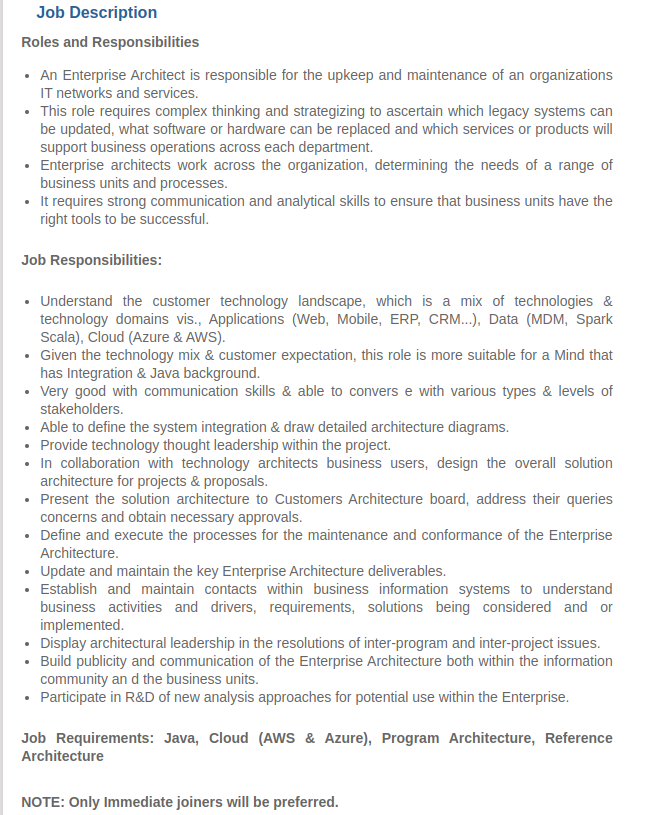Why Engineers Hate your “Boiler Plate” Job Descriptions?
How to Attract the most relevant applicants with great job postings
One of the main problems in SaaS/Software engineering hiring is the way job descriptions are written. While I knew this for some time (read years) The problem is, I was too lazy to change anything about it! That is until recently, one of the candidates I was interviewing for an Engineering Manager Role said this in our introductory call,
Me: Hope you’ve had a discussion with Ms.ABC (our HR) regarding the Roles and Responsibilities. If there are questions on it I can answer them, or we can get into the agenda.
Candidate: Yes I had a discussion with Ms. ABC. But, quite frankly it was your boilerplate JD. I’d actually want to understand what exactly I’d be doing. What will I be in charge of? What will I move?
Needless to say, I spent the next ~30 minutes walking through the current team structure, where he’d come in, what will he own, what the growth trajectory looks like etc. Ultimately, we did 2 more calls before both of us were satisfied that there are mutual synergies and went ahead. It made me reevaluate all of our Job Descriptions over the weekend and rewrote almost half of them to include factual details on projects, outcomes expected, tools available, glimpse of growth among other things.
After this, I asked the HR to send this “revised” JD to the candidates once again.
And the result was visible from Monday!
Either candidates that the HR thought super suited started dropping voluntarily from the process or candidates started expressing interest, doing more research on our stack, infra, product proposition and competitor benchmarking, before the call. Some even did a cold reach-out on Linkedin.
So, I wanted to share the small titbit here.
Why General Descriptions Don’t work?
Most Job descriptions barely resemble “specifications” at all, but feel more like generic stubs. Sort of like the equivalent of shopping for a car with as much details as “red and goes fast” or “black and built to last.”
It leaves too much open to the imagination for it to be a successful criterion to enable fitment. With criteria as broad as this you’ll end up spending an inordinate amount of time executing the search, since so many things appear to be a match. For me, Red and goes fast is always a 1971 Ford Mustang, for you it could be a 1998 Ferrari 365.
The truth is that statements like the above — or its equivalent in engineering hiring — “Get me a backed dev with OOPS in Python/Java/Go with 5 years experience” — guarantee a similarly frustrating shopping experience. You’ve made it needlessly difficult for yourself and your HR/TA team to identify the specific talent you want. In this trite example you’ve indicated that you’re looking for a mid-level engineer that knows OOPS, but that basically includes everyone that ever graduated with a CS degree in the past 5 (to 10?) years. Surprisingly, many job “specifications” we see contain rarely any more info. These are the “Boiler Plate” Job Descriptions.
How did we find ourselves in this mess?
I understand why hiring managers do this. Sometimes they’re not exactly sure what they want — after all, it takes real time and effort to work out the specific vision for the role. But instead of acknowledging this and then solving the real problem (their own laziness), they delegate the JD writing to their Team/HR and it turns into generic tech JD. But the hiring manager is unfazed — “I’ll know the right candidate when I see them,” they say. Really? It could be true in some instances. Sometimes, we start with a Backend developer, then we come across a candidate with experience in building a full pipeline or a payment system. Then we expand the role to cover wider scope and evaluate against it. But generally, How will they know the right candidate if they can’t write down specifically what the candidate looks like?
Another reason for generic job specs is because a hiring manager is recruiting in a talent-constrained market (sound familiar?), and it feels like a smart move to cast as wide of a net as possible. Theoretically, one should be able to get more candidates into the top of the funnel this way, right?
Perhaps. Theoretically. But in my experience, this approach usually, and utterly, backfires. Here’s why:
Boiler Plate Job Descriptionsaren’t designed to appeal to any engineer in particular
In the current job market, engineers are faced with a wide variety of options from some amazing established companies and lots of seemingly “sexy” startups. (after “the great resignation”)
You need to take your opportunityto stand out! The more specific you are about the challenges a specific engineer will get to work in a specific role, the more traction you’ll get with (the right) candidates.
The idea is to make an engineer excited when you describe what they will “Get to do” in the first 12-15 months in the role.
Be very specific,
- Talk about the product/modules they will own/drive/be part of,
- Talk about the outcomes and metrics they will own and drive,
- Talk about the toolchains & frameworks they’ll use (or get to choose),
- Talk about What’s hard/challenging about the role, How are they a great fit.
- The more details you can squeeze into the spec to help them visualize their role and the projects they’ll be working on the better.
Boiler Plate Job Descriptions don’t arm others to help you
Another bad thing about generic JD is that they don’t help others help you. Think of how much reach could you get by using everyone in your network as a recruiter. But in today’s scenario, “everyone else” is already asking them if they know any Python Engineers or React Developers or Go Engineers. Why would they help you? Because you’ve taken the time to get specific about what you want? Maybe.
Take a look at the following Job Description. Anyone in software engineering who had some deployment, infra-planning & communication seems to be a candidate for the role.
I recently got a request from a founder friend of mine to refer a Sr.Tech Lead/Engineering Manager for an early-stage startup. When I saw the JD, it was so generic it did not even have the primary stack on it. Assume sharing it from your handle. I politely declined to share it and asked for some more information and said will come back once he shares. (I believe he is very busy and hence hasn’t come back)
The bottomline is, Make them want to help you — give them a JD that’s so amazing, well-written, specific, (even entertaining) — that they can’t help but pass it on, post it, tell their friends about it, etc. If you make it stand out — you’ll get more attention from the folks that can help because you’ll arm them with something interesting & effective that they can use to reach out to their network.
Boiler Plate Job Descriptions don’t enable you to know what success looks like
This is a very simple point — see above — if you can’t explain what the ideal candidate looks like, how will you know when you’ve found them? The JD shared by my friend looks as vague as this.

Actually, his company was looking for a guy who could not just do Infrastructure Architecture. They wanted someone who has architected/built a cloud native SaaS application. His team has built the application and has no idea how to convert it to truly cloud native format to scale without breaking the bank!
The main idea here is about not being willing to settle for less. I realise the market is tough right now, and maybe you’ll need to make compromises. But do you want to start at the wrong end of the pool? When you go out the door with a generic description, you preemptively give up the battle. If you need to settle — fine! — but know exactly what points you’re compromising on.
The larger problem is that if you don’t know what the best candidate really looks like then the other people involved in making a decision likely don’t know what s/he looks like either. A well-defined, specific description of the role enables everyone involved in the interviewing and hiring process to be on the same proverbial page.
Now go get started!
Fixing your job descriptions will take some work(as I found out). To get to specifics, you’ll need to dig in and make additional efforts. You might also need to do some retraining in your organization and teach others these principles, too.
But when you get through the hard work, your postings will turn into valuable weapons that will,
a.) appeal to the engineers you want to reach,
b.) enable others to help you expand your outreach, and
c.) get your hiring team on the same page to quickly come to the right decision.
If you’re curious to see what roles we currently hire for, we have a lot of openings in Product, Design and Engineering:
It ranges from Kubernetes Architect, React Native Mobile Dev, Sr.Backend Dev, Tech Lead-Mobile Technologies, Engineering Managers, Associate Product managers, Product Managers etc.
More details can be had at https://angel.co/company/itilite-1/jobs or you can ping me 🙂






